Hippopotamus ivory cylinder seal
Σ-Κ1039
Bone (Hippopotamus tooth)
Intact
Height: 3.2 cm. Max. Diameter: 3.5 cm.
Platanos
Annexe ζ
Early-Middle Bronze Age. Prepalatial period. Early Minoan ΙΙΙ- Middle Minoan ΙΑ period:
2200-1900 BC:
Gallery:
ICase:
13Exhibition thematic unit:
Early Bronze Age - Prepalatial period (3000 - 1900 BC). Settlements and cemeteries - the rise of ruling groupsSeals
Description
Seal of hippopotamus ivory with two circular sealing surfaces where the tooth was cut. Its shape, its material and the configuration of its sealing surfaces make this one of the most characteristic examples of Early Minoan seal-carving. The larger sealing surface depicts seven lions parading clockwise with six spiders in the centre, while the smaller surface bears three scorpions. The seal had been placed as a funerary offering in the annexe of a communal tholos tomb in the rich cemetery of Platanos in the Mesara. The theme belongs to the “Parading Lions Group”, reflecting Eastern influences. The spiders and scorpions, bearers of apotropaic/magical qualities, appear on seals of the period which are thought to have also been used as amulets. Besides their probable practical use in sealing, they were also objects of high aesthetic value and helped to display the social status of those who wore and used them.Bibliography:
Xanthoudides, S. 1924. The Vaulted Tombs of Mesara. An account of some early cemeteries of Southern Crete. London. Krzyszkowska, O. 2005. Aegean Seals. An Introduction. University of London. Platon, N. 1969. Iraklion Archäologisches Museum.Die Siegel der Vorpalastzeit. CMS II, teil I. Berlin.Author:
I. G.Photographs' metadata
